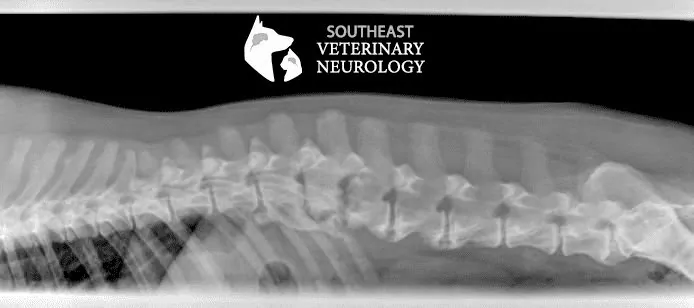Discospondylitis in Dogs
What is discospondylitis?
Discospondylitis in dogs is the infection of an intervertebral disc and the vertebrae sitting on either side of it. The word “discospondylitis” combines three meanings: disco refers to the intervertebral discs cushioning the bones of the spine, spondylo refers to vertebrae, and itis means infection or inflammation.
Infection and swelling of the spine can significantly alter your pet's quality of life. Contact us to see how we can help.
What are symptoms of discospondylitis?
Large-breed male dogs are affected more than any other breed, and symptoms may include:
- Lethargy
- Lack of appetite
- Weight loss
- Fever
- Pain
- Stiffness
- Reluctance to move
- Weakness
- Incoordination
- Difficulty walking
- Paralysis (severe cases)
These symptoms are similar to those seen in dogs with IVDD, meningitis, broken bones, and tumors. Therefore, veterinary neurologists at Southeast Veterinary Neurology (SEVN) will need to thoroughly examine your dog to determine the exact cause of their symptoms.
How do dogs get infected with discospondylitis?
Infection takes place when bacteria or fungus lodges in the intervertebral disc and its adjacent vertebrae, causing an abscess to form. Dogs can become infected in several different ways:
- When bacteria or fungus enters the bloodstream
- Through direct contamination (bite or puncture wound over the spinal column)
- A migrating foreign body (like a grass awn) that entered the body via inhalation, ingestion, or a penetrating wound
Discospondylitis is most frequently caused by bacteria including E. coli, staphylococcus, streptococcus, and brucella and less frequently by fungus.
Diagnosing Discospondylitis in Dogs
The infection is usually widespread in the body, meaning it is present in other organs such as the urinary system or heart valves. We can most accurately diagnose discospondylitis with the following tools:
- X-rays may help us see infection of the disc and bones, which is shown as wider or narrower than normal disc space between the affected vertebrae and irregularity of the edges of the bones (end plates).
- We may also recommend CT and MRI if discospondylitis is not apparent in X-ray images or when weakness or wobbliness is present.
- Blood and urine testing are also helpful for finding out what bacteria are responsible for your dog’s infection and which medicine is best to treat it.
- In some cases, we might also recommend surgery to obtain tissue samples.

Discospondylitis in a dog. T13-L1 and L1-L2 are involved.
The caudal end plates of T13 and L1 and the cranial endplates of L1 and L2 are irregular.
Any intervertebral disc can be affected; however, the L7-S1 disc is most common.
Available Forms of Treatment for Discospondylitis in Dogs
Based on results obtained from your dog’s culture and sensitivity test, we will prescribe antibiotics to treat the infection for six to eight weeks, as relapses are common if not treated long enough. Additionally, we will provide pain relief medication to keep your dog comfortable.
On some occasions, we might recommend surgery to remove the infection.
Prognosis depends on the type of infection and how affected the patient is. As examples, fungal infections tend to be worse than bacterial infections, and paralyzed dogs that are unable to feel their back legs have a worse prognosis than those with less severe symptoms.
Follow-Ups Can Prevent a Relapse
If your dog is being treated for discospondylitis, it needs close monitoring and regular follow-up exams, blood work, and possibly MRIs. We need to ensure that your dog is responding well to medication and showing no signs of an early recurrence.

